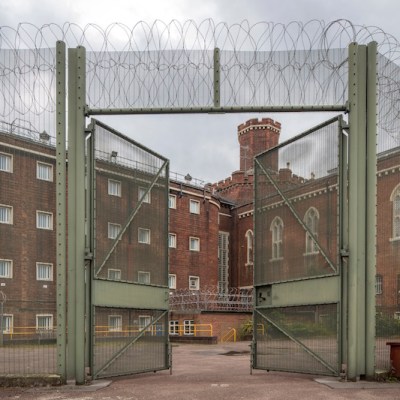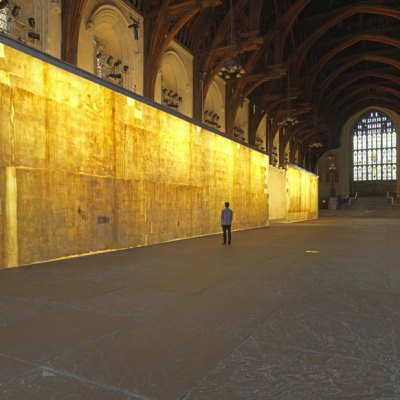For a show that is all about the great outdoors, there is much about Andy and Peter Holden’s brilliant ‘Natural Selection’ that is domestic. The nests and eggs with which Holden has filled the old Newington Library on Walworth Road are the fundamental particles of domesticity – the stuff that all homes and families are spun out of. And though this is a show that glories in the performance of those superficially dispassionate disciplines ‘natural history’ and ‘social history’, homes and families are what it comes back to over and over again. The cosy comforts, private spaces, and hidden places of the former; the genes and generations, the shared faces and inherited knowledge of the latter.
Inherited knowledge is the crux of it all. Andy Holden has billed this as a collaborative show, giving his father Peter Holden equal credit for supplying the expertise around which ‘Natural Selection’ is based. If you ever signed up to the RSPB, you’ll know Peter Holden’s name: one of the society’s prime movers, he quite literally wrote the book on British birds and holds an MBE for his services to British twitching. Birds and their habits were clearly part of his son’s life from the get-go. On the double covers of the book documenting the two main pieces in ‘Natural Selection’ are photos of Andy Holden as a toddler, clutching copies of Bird Life and British Birds. The knowledge, though, was not passed down directly. It was not until a fallow period in Andy Holden’s life when, living at home with his parents, he found himself fascinated by a nest in the garden, and asked his father to initiate him into ornithology.
Visitors watching A Natural History of Nest Building (2017) seen through Untitled (Bower) (2017), both by Andy Holden. ‘Andy Holden & Peter Holden: Natural Selection’ (2017), an Artangel commission. Photo: Liam White

It is possible to anticipate the kinds of resonances that Andy Holden sets up in this display. A Natural History of Nest Building stages a lecture on its subject as a father-son dialogue, across three screens, in a style that is clearly a loving homage to the educational programmes of the 1980s. It is, in plenty of ways, straight educational TV – packed with slides and clips, and diagrams, and direct explanations of the different varieties of birds’ nests across the world. But it also poses a series of questions about nature, knowledge, and art: Why are nests so unique species to species? How do birds know how to make these specific forms? Where does the technical expertise necessary to make the most complex structures come from? At what point, if any, does avian evolution tip over into something like creativity, or even art?
Can we really credit birds with artistic expression? The star exhibit for Andy Holden in this regard is the bowerbird in its various species. Alongside a display case containing various examples of the small nests discussed in the film stands a human-scale replica of a bowerbird’s bower. It is a gorgeous structure: a pathway of willow withies densely woven into an almond-shaped aperture that guides the eye down the room towards the video screens. Like much in nature, it is beautiful, but we tend not to class nature and art as belonging to the same category of beauty. Bowerbirds break the distinction. ‘Nest’ is not quite the right word for the structures they build: as ‘Natural Selection’ explains, no birds nest there, no eggs are laid there; they are display structures, built by males to attract females. And though the basic forms are defined species by species, each seems to be an individual expression of a male’s personality, and often they are adorned with collections of colourful objects, arranged carefully. If a human moves a pile, augments or reduces it, the bird will put it back to the way it was – the way, it seems, that the bird wanted it.
Visitors studying porcelain eggs that make up the installation ‘How the Artist Was Led to the Study of Nature’ (2017), Andy Holden. ‘Andy Holden & Peter Holden: Natural Selection’ (2017), an Artangel commission. Photo: Liam White

The Holdens leave the question of whether this is art open. But the affinities are clear. Just as with the bowerbird’s pathway, the openness of their approach is what induces perspective, guides the eye, and focuses the mind.
The second half of the show retreats into smaller spaces, literally and figuratively. In the warren of basements under the library, which still contain an old safe and shelves labelled for the local rent and rates accounts, the visitor comes to A Social History of Egg Collecting. After the cosiness of A Natural History of Nests, A Social History of Egg Collecting reveals a darker side to naturalist obsession. It is still about knowledge and procreation, but from an angle that, as Holden points out, entails ‘loving an object so much that you would risk destroying the very thing that produced it’.
The centrepiece of A Social History of Egg Collecting is ‘How the artist came to the study of nature’ – a recreation in porcelain of the collection of eggs amassed illegally by amateur oologist Richard Pearson. The eggs have been carefully remade from photos of the original haul by ceramicists Peter and Eileen Rowland; they number in the hundreds and sit swaddled in cotton wool in a variety of old cardboard boxes, biscuit and sweet tins. Many belong to endangered species – Pearson’s thirst for collecting was such that it eclipsed all other considerations. The real collection was destroyed in 2006, so as to give no encouragement to other collectors who might dream of seeing their hordes enshrined in museum collections, despite their illegality.
How the Artist Was Led to the Study of Nature (2017), Andy Holden. An Artangel commission. Photo: Marcus J. Leith

‘How the artist came to the study of nature’ is both majestic and sad in how it recapitulates the journeys its eggs have gone on: from live to dead; from nest to biscuit tin; from high in trees to hidden in a cellar; but, also, from one kind of home to another. As A Social History of Egg Collecting makes clear, many modern oologists are men who have failed to nest. But theirs, too, is a species of knowledge, passed on and shared through underground networks.
There is something almost laughably basic about the symbolism of nests and eggs – they form part of that select family of natural objects that seem always to already be metaphorical on some level. They hum with resonances: not just of homes and families, but safeness and precariousness, concealment and exposure, perfection and imperfection … the list could continue indefinitely. The triumph of ‘Natural Selection’ is to magnify those resonances in all directions, and to produce something simultaneously didactic and aesthetic, straightforward and puzzling. In a beautiful essay written to accompany A Natural History of Nest Building, Helen Macdonald writes that if you hold a falcon egg up to your mouth and cluck softly, a chick that is ready to hatch will cluck back. ‘Natural Selection’ does the same, on a scale at once vastly magnified and entirely intimate. Go and see it before it flies the coop.
The Artangel project ‘Andy Holden & Peter Holden: Natural Selection’ is at the former Newington Library, London, until 26 November.
Visitors watching A Natural History of Nest Building (2017), seen through Untitled (Bower) (2017), both by Andy Holden. ‘Andy Holden & Peter Holden: Natural Selection’ (2017), an Artangel commission. Photo: Liam White




